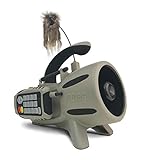Coyote hunting is one of the most popular predator hunts in the US.
This surprises no-one, with the possible exception of the Road Runner.
Three-dimensional coyotes are cunning, intelligent animals, so it makes sense that people want to hunt them – the challenge of pitting our wits against such a dynamic predator gets our heart pumping, makes the hairs stand up on the back of our neck, and sends adrenaline round our bodies as much as any high-speed race.
When it comes to coyote calling, hunters are divided into those who prefer mouth calls, which are complicated and take a lot of practice to master, and those who prefer electronic calls, which deliver consistent sounds, and usually consistent results.
But electronic technology is always evolving, meaning there are lots of electronic calls on the market. So how do you know which are the genuine aids to hunting coyote, and which are just bells, whistles and howls for the sake of it?
Give us a call, of course.
We’ve hunted down the best coyote electronic calls for you. Take a look at the top dogs.
In a hurry?
This is our Winner!
Our Pick
Why it’s Our Top Pick
You know the feeling you get when you scent a great deal in the air and you think no-one else has noticed yet? That sense of anticipation, of impending triumph and excitement?
That’s the feeling you get with the FOXPRO Deadbone call. It shouldn’t do as much as it does for under a hundred dollars. It shouldn’t do what it does anywhere near as well as it does for under a hundred dollars.
But it does – and now you know about it. There are 15 calls pre-loaded onto the Deadbone – some predator, some prey. They include:
- Coyote Locator
- Female Coyote Howls
- Female Coyote Challenge
- Coyote Pair
- Coyote Pup Distress
- Jackrabbit, Cottontail
- Snowshoe Hare, and
- Baby Cottontail
That’s quite enough to see you through many a coyote hunt.
Best Coyote Electronic Calls - Comparison Table
Rank | Product Image | Product Name | Buy on Amazon |
|---|---|---|---|
1 | |||
2 | |||
3 | |||
4 | |||
5 |
Best Coyote Electronic Calls - Reviews
The Deadbone is made of a thick plastic composite knows as ABS, specifically developed to be both lightweight and at least as rugged as you are.
That means the Deadbone can go with you on any coyote hunt, and will stand up to terrain, weather, and even use in snow – a particularly testing challenge for electronic calls.
It has a powerful horn, and a particularly useful feature on the Deadbone is its ability to play two sounds at once, adding to the realism of its performance.
With only 15 calls in its electronic repertoire, the Deadbone is hardly the Swiss army knife of coyote calls.
But its ruggedness, its reliability, its do-everything-you-need flexibility and its absolute rock-headed refusal to give up the ghost make it the Bowie knife of the coyote electronic call world, and all for under a hundred dollars.
That’s what makes the Deadbone our top pick on this list – flexibility, tenacity and outright enthusiasm for any coyote calling challenge.
Pros
Cons
Another entry-level coyote electronic call from another leading name in the industry for under a hundred dollars, the Primos Dogg Trap is a direct challenger to the Deadbone in terms of its main features.
Like our list-leader, the Dogg Trapp claims to allow you to make two sounds at the same time.
However, some users say this only refers to single pre-recorded sound files of more than one noise at a time.
It has extendable legs so you can use it in most coyote terrains. And in flat areas, you can expect the Dogg Trap to call coyote effectively at anything between 500 and 700 yards.
Where it falls short of the Deadbone is in the gap between what it promises and what it delivers. The remote range of this call is advertised at around 50 yards, whereas users have repeatedly reported the actual range at which the remote works is just half that distance.
Whether it lags behind the Deadbone in range of calls is a matter of opinion. It lists only ten programmed calls in its voicebox. But it also includes two pre-programmed hunts by Randy Anderson, and unlike the Deadbone, it does allow you to make your own sequences and load in your own sound files in MP3 format, meaning it makes a much broader range of sounds available.
Ultimately, the Deadbone takes our top spot for its ruggedness and straightforward operations, but the Dogg Trap is a highly respectable call with a wider potential over time, and also with the ability to control decoys at a reasonable distance.
Pros
Cons
Moving up into the big leagues, you’re always going to get a sense of extra pleasure.
Like being bumped from Premium Economy to Business Class, the Icotec GC500 is in a different class to our two top scorers. Except here, you haven’t been bumped up, you’ve consciously paid twice the price, so the GC500 has to justify its higher cost.
It makes a great fist of doing that.
The first couple of clues as to where your extra money’s gone are in the name. Forget double digit figures of pre-loaded calls, the Icotec call includes 200 pre-loaded professional calls.
That’s going to see you through an awful lot of coyote hunting.
In fact, one of the dangers of having so many pre-loaded calls is choice overload – like having two hundred cable channels available to watch, and trying to find the precise thing you want to watch at any moment.
Fortunately, Icotec takes the ‘programmable’ element of its call up a notch, allowing you to save 8 calls on two Favorites screens.
That’s just as well because programming and choosing the right calls can be tricky in the moment when you need them with the Icotec – which is one of the reasons it doesn’t score higher on our list.
The sound projection on the GC500 is fine for most coyote hunting, and the remote range is up to 300 yards, even with no direct line of sight to the call.
Make no mistake – the Icotec GC500 will call coyote to you with a regularity that will make you happy.
But it’s by no means the simple grab-and-go technology of our first two products, and while there are some issues of fiddly technology and too much choice, there’s also been some recent corporate wrangling which has left many users less impressed than they used to be with the GC500.
In particular, it used to be easy to download additional calls from a library and sequence them into the GC500. Recently though, the arrangement has changed and downloading free additional calls into the machine has become more difficult.
Ultimately then, the Icotec GC500 is a Business Class upgrade on a plane with a couple of wobbly wheels – it will still do what it says it’ll do, and do it extremely well once you’re familiar with its tricky display and navigation, but the GC500 has issues of complexity that might make you think twice before spending twice the money of a Deadbone or a Dogg Trap.
Pros
Cons
If the Deadbone is the Scrappy Doo of the FOXPRO range, then the Inferno is the Scooby.
More grown-up, more useful, and when all is said and done, the reason anybody tunes in.
So why isn’t it ahead of the Deadbone in our list?
Mostly it’s down to a sequence of niggling things, though being almost twice the price, competing more with the GC500 than with its ‘nephew’ product is key, because it means it has to do more to get our attention than the budget model does.
It certainly does more – it comes with 75 calls pre-loaded, and give you the space to add 125 more, matching the initial 200 of the GC500.
But it scores over the Icotec in two important respects. Firstly, the remote is much clearer to read. And secondly, crucially, like a gift from the hunting gods, it allows you to organise your calls into types. You know you’re going to need coyote vocalizations – bang, pull them all together and use a kind of ‘folder’ structure to access them in a hurry.
Think playlists on your iTunes or Spotify player. Where the Icotec call simply lists everything in your music collection in a long sequence, the Inferno lets you find your favorite tunes – or in this case, calls - fast.
Also like your iTunes or Spotify player, the Inferno lets you plug into a computer via a simple USB in order to reprogram its ‘playlists’ and build the sequence of vocalizations and sounds you want for your next hunt. It also comes with access to a free sounds library, though some users caution that all the ‘good’ sounds are only available to buy, rather than download for free.
The Inferno is built out of FOXPRO’s rugged ABS material, and weighing in at under 1.5 pounds, it’s hardly a heavyweight in terms of adding to your burdens, especially given everything it can do to add to the success of your hunt.
Naturally, there’s no compromise in the sound production capabilities of the more expensive FOXPRO unit – the Inferno has been clocked at 600 yards and more by the human ear, and of course by comparison, the coyote’s hearing is significantly more powerful.
One of the Inferno’s most appealing features though is FOXBANG. FOXBANG is a system which allows the caller to automatically switch to an assignable function after you fire your shot. That means hands-free sound changing, so you can focus on the field.
With all of this in the Inferno, you’re probably wondering why it doesn’t score more highly on our list.
It would, but for the experience of users. While many – in fact, by far the majority – appear to have had no issues with their Inferno, there are a significant number of users who report inconsistencies with what they receive. Some report receiving the product with parts missing, damaged or not working as advertised, from cords to screens to packaging.
These reports add an uncertainty to the buyer experience that currently pushes the Inferno down our list, for reasons that are technically nothing to do with the build quality, ingenuity or effectiveness of the product when correctly supplied.
If you’re one of the vast majority who receive your Inferno as it should be, it overtakes the Icotec in our rankings as a great mid-range programmable call with some useful, thoughtful additional features.
Pros
Cons
The Icotec GC320 call/decoy combo takes us full circle, but with furry knobs on. It’s a non-programmable call with just 24 pre-loaded options, so we’re back in the land of grab-and-go, relatively simple calling technology – but now with a decoy slaved to the call.
As with our list-leader, you can play two sounds at the same time on the GC320, and you can play them through the 12 watt speaker, or if you need extra howl for your buck, you can plug in an auxiliary speaker to boost the range of your calling.
The remote on the GC320 takes notes from typewriter and keyboard technology – each button has two call sounds assigned to it, and you simply switch between them with the flick of a button, like switching from lower case letters to capitals on a keyboard.
That’s an attractive, simple solution to the problem of choice when you’re out on a hunt and don’t actually want or need every animal sound ever made at your disposal, only the ones that work.
One thing to note about the GC320 which pushes it significantly down our list is that it’s not considered waterproof, so while it’s a good grab-and-go option on hot hunts, taking it out on potentially wet or snowy hunts is likely to fritz this otherwise solid and simple call.
Bottom line, the GC320 is a good call with attractively thought-out solutions to the problem of choice and a decoy thrown in, but either of the two calls that top our list will give you more reliable performance in a wider choice of terrain and conditions.
Pros
Cons
Best Coyote Electronic Calls - Buyer's Guide
When buying a coyote electronic call, there are a number of key points to consider.
How many sounds do you actually need?
If your hunt will involve a very diverse natural ecosystem, by all means, go up the pricing scale, get yourself a programmable monster with hundreds of call and sound file options – it will pay you dividends when you’re able to convince the local wildlife you’re not a predator, and lure them into your cross-hairs. If on the other hand your hunt is in relatively straightforward territory, you can afford to come down the pricing spectrum and get yourself a scrappy model with plenty of relevant sounds, less complication, less learning, and still get excellent results.
How free is free?
Many programmable calls offer access to a bank of free calls and sounds which you can download into your coyote electronic call. Check out these libraries before you buy the call – some are more complicated to use than others, and some reserve the sounds that are most practically useful behind additional payment processes.
Weather or not?
Only you know the terrain and the likely weather in your coyote hunting grounds. Be sure to keep it in mind when buying your call though – the last thing you want is to pay big money for a call that shrivels up and dies when you take it out in the rain or the snow. Be weather wise and buy according to your regular hunting practices.
So near and yet so far.
Keep the distances and the terrain in mind too – if you need a call that will reach coyotes over vast distances, make sure you get a call that’s either loud enough to reach them on its own, or has the option to plug in additional speakers so you can reach the ears of the coyote.
Frequently Asked Questions
Aren’t electric calls just cheating?
No, they’re the application of modern science to an ancient discipline. Some purists will always think of them as cheating, but then some purists once thought taking rifles hunting was unacceptably modern, compared to longbows carved from trees.
Ultimately, whatever makes your hunt better and gives you what you want from the experience is fine. Give yourself permission to enjoy hunting with coyote electronic calls.
Should I take a mouth call with me too?
Back-up’s never a bad idea, especially in the event of freak weather than might fry your otherwise sophisticated electronic call. That said, the point of using electronic calls is that they free you from the difficult business of learning to use mouth calls in the first place.
Take one by all means if you want to be doubly safe – but that means learning to use it well, or it’s worse than useless.







